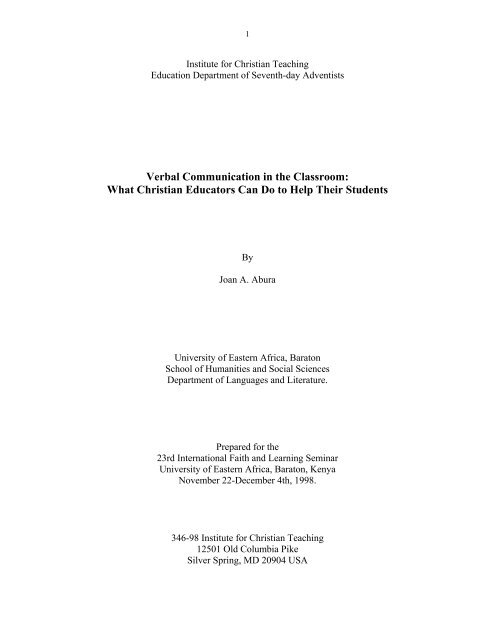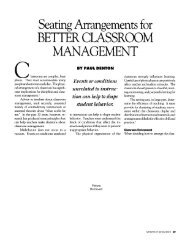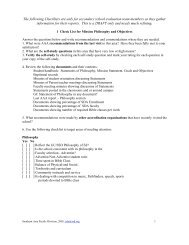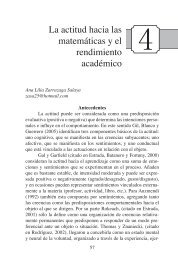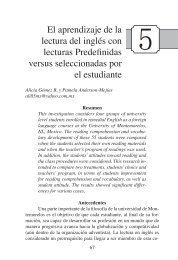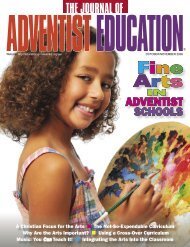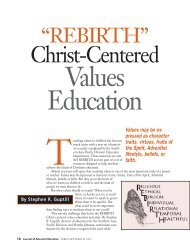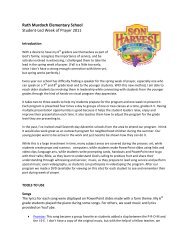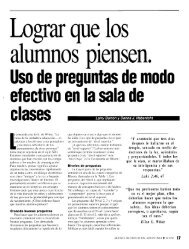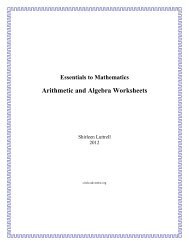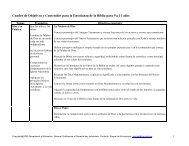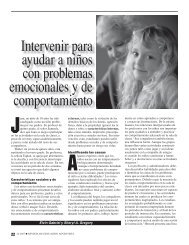Verbal Communication in the Classroom: What Christian ... - Circle
Verbal Communication in the Classroom: What Christian ... - Circle
Verbal Communication in the Classroom: What Christian ... - Circle
Create successful ePaper yourself
Turn your PDF publications into a flip-book with our unique Google optimized e-Paper software.
1<br />
Institute for <strong>Christian</strong> Teach<strong>in</strong>g<br />
Education Department of Seventh-day Adventists<br />
<strong>Verbal</strong> <strong>Communication</strong> <strong>in</strong> <strong>the</strong> <strong>Classroom</strong>:<br />
<strong>What</strong> <strong>Christian</strong> Educators Can Do to Help Their Students<br />
By<br />
Joan A. Abura<br />
University of Eastern Africa, Baraton<br />
School of Humanities and Social Sciences<br />
Department of Languages and Literature.<br />
Prepared for <strong>the</strong><br />
23rd International Faith and Learn<strong>in</strong>g Sem<strong>in</strong>ar<br />
University of Eastern Africa, Baraton, Kenya<br />
November 22-December 4th, 1998.<br />
346-98 Institute for <strong>Christian</strong> Teach<strong>in</strong>g<br />
12501 Old Columbia Pike<br />
Silver Spr<strong>in</strong>g, MD 20904 USA
2<br />
I. Introduction:<br />
In communication, it is possible to f<strong>in</strong>d a situation where two people say exactly <strong>the</strong> same<br />
th<strong>in</strong>g to a given audience, us<strong>in</strong>g exactly <strong>the</strong> same language, even <strong>the</strong> same words, but <strong>the</strong> two<br />
will end up pass<strong>in</strong>g two different messages. You may also come across a situation where a<br />
person has been completely misunderstood by his/her listeners. There are many problems that<br />
families encounter that on closer analysis reveal <strong>the</strong>ir orig<strong>in</strong>s <strong>in</strong> miscommunication between<br />
family members--- and <strong>the</strong> list could go on. The question is, what is it about communication that<br />
br<strong>in</strong>gs about difficulties <strong>in</strong> understand<strong>in</strong>g even amongst people who speak <strong>the</strong> same language?<br />
In communication <strong>the</strong>re are different elements that must work toge<strong>the</strong>r <strong>in</strong> harmony to facilitate<br />
effective communication. In verbal communication <strong>the</strong>se elements <strong>in</strong>clude <strong>the</strong> sender of <strong>the</strong><br />
message, <strong>the</strong> receiver or listener, <strong>the</strong> message itself, <strong>the</strong> channels through which <strong>the</strong> message is<br />
sent, and feedback.<br />
<strong>What</strong> goes on <strong>in</strong> <strong>the</strong> classroom is not different because educators are essentially engaged<br />
<strong>in</strong> communication as <strong>the</strong>y teach. For many of <strong>the</strong>m, <strong>the</strong> many years of experience that <strong>the</strong>y have,<br />
may lead <strong>the</strong>m to believe that <strong>the</strong>y are effective communicators. For those who are relatively<br />
new <strong>in</strong> <strong>the</strong> profession, <strong>the</strong>ir lack of experience <strong>in</strong> <strong>the</strong> art of communication might manifest itself<br />
from time to time even before those that <strong>the</strong>y teach.<br />
Many teach<strong>in</strong>g methods irrespective of discipl<strong>in</strong>e have moved over <strong>the</strong> years from<br />
teacher-centered approaches where <strong>the</strong> teacher is seen as <strong>the</strong> source of all knowledge to<br />
approaches that are more learner-centered. In <strong>the</strong> Languages for example, what this shift has<br />
brought with it is ample opportunities for students to experiment with language as <strong>the</strong>y actively<br />
participate <strong>in</strong> <strong>the</strong> learn<strong>in</strong>g process. Such methods foster fluency <strong>in</strong> second language learn<strong>in</strong>g.<br />
The teacher's role has changed from that of controller to facilitator or guide. These are known as
3<br />
communicative approaches to language teach<strong>in</strong>g, where communication is seen as <strong>the</strong> focus for<br />
language learn<strong>in</strong>g. It is for this reason that <strong>the</strong> author deemed it necessary to explore ways <strong>in</strong><br />
which <strong>the</strong> <strong>in</strong>dividual student can be assisted so that he/she can ga<strong>in</strong> from <strong>the</strong> <strong>in</strong>structions offered<br />
<strong>in</strong> <strong>the</strong> various fields of education <strong>in</strong> schools, colleges, polytechnics and universities. The paper<br />
looks at ways <strong>in</strong> which optimum communication can be achieved through teacher-student<br />
<strong>in</strong>teraction <strong>in</strong> <strong>the</strong> classroom. It is <strong>in</strong> three parts:<br />
Part one of <strong>the</strong> paper looks at student expectations as participants <strong>in</strong> <strong>the</strong> communication<br />
process; part two is focused on self-concept <strong>in</strong> verbal communication while part three<br />
underscores <strong>the</strong> important role played by <strong>Christian</strong> faith <strong>in</strong> <strong>Christian</strong> education.<br />
II.<br />
Student Expectations:<br />
Like <strong>in</strong> any communicative event, students are expected to have goals which <strong>in</strong> turn<br />
<strong>in</strong>fluence <strong>the</strong>ir expectations <strong>in</strong> every course that <strong>the</strong>y undertake to study. In many a classroom,<br />
different students will have different expectations. Some students just hope to score good grades<br />
at <strong>the</strong> end of <strong>the</strong> course, o<strong>the</strong>rs barely hope to endure <strong>the</strong> agony of go<strong>in</strong>g through three or so<br />
months of <strong>in</strong>struction, yet <strong>the</strong>re is ano<strong>the</strong>r group who really don't have any expectations, for<br />
<strong>the</strong>m, formal learn<strong>in</strong>g is seen as part of life, someth<strong>in</strong>g that one goes through because <strong>the</strong>y<br />
happen to be, how <strong>the</strong>y feel about it is not important. Some members of <strong>the</strong> second group, when<br />
asked why <strong>the</strong>y go to school at all, have been heard to say that <strong>the</strong>y go to school to please <strong>the</strong>ir<br />
parents. Whereas one might <strong>in</strong>terpret such a response to show love for parents, go<strong>in</strong>g by <strong>the</strong>ir<br />
attitude, <strong>the</strong>re's no love manifested <strong>the</strong>re. Such students need to know that <strong>the</strong>y are expected to<br />
take <strong>the</strong>ir places <strong>in</strong> society as <strong>in</strong>dividuals and that <strong>the</strong>y should not claim to please <strong>the</strong>ir parents.<br />
This is where <strong>the</strong> <strong>Christian</strong> educator is expected to make a difference because <strong>Christian</strong><br />
education is both transformative and transcendent.
4<br />
Transformative because we believe that by God's grace, all th<strong>in</strong>gs are possible, we also<br />
believe that Christ died on <strong>the</strong> cross to save s<strong>in</strong>ners. Transcendent because <strong>Christian</strong> education<br />
goes beyond certificates, diplomas and degrees to concern itself also with character mold<strong>in</strong>g for<br />
eternity. In this connection, Rasi(1998) makes <strong>the</strong> follow<strong>in</strong>g observation, character is what helps<br />
us to connect what we learn with what we do, it is <strong>the</strong> bridge that takes us from knowledge to<br />
ethical choices, it is <strong>the</strong> glue that br<strong>in</strong>gs coherence between what we believe and how we behave<br />
<strong>in</strong> private or <strong>in</strong> public. Thus, <strong>the</strong> importance of character mold<strong>in</strong>g cannot be over emphasized.<br />
There are practical examples of parents whose children have excelled academically and have<br />
qualified to study <strong>in</strong> prestigious universities, but have opted for <strong>Christian</strong> education <strong>in</strong> some<br />
humble <strong>Christian</strong> <strong>in</strong>stitutions just because of this po<strong>in</strong>t. This is <strong>the</strong> reason why, as <strong>Christian</strong><br />
educators, we must realize and appreciate <strong>the</strong> responsibility that we have towards <strong>the</strong> young<br />
people entrusted to our care.<br />
III.<br />
Self-Concept <strong>in</strong> communication:<br />
It is a normal human feel<strong>in</strong>g to seek <strong>the</strong> approval of those that we care for. Small babies<br />
are well settled <strong>in</strong> <strong>the</strong> arms of <strong>the</strong>ir mo<strong>the</strong>rs when <strong>the</strong>y can sense approval and content usually<br />
communicated via body language, a hug or a smile. When young children <strong>in</strong>volve <strong>the</strong>mselves <strong>in</strong><br />
attention ga<strong>in</strong><strong>in</strong>g activities, <strong>the</strong>y are look<strong>in</strong>g for approval or acceptance. In all human endeavors,<br />
learn<strong>in</strong>g <strong>in</strong>cluded, one feels good when <strong>the</strong>y know that <strong>the</strong>ir efforts are recognized and valued by<br />
o<strong>the</strong>rs. The Bible calls it love and <strong>the</strong> book of John tells us about this love; how Christ loved us<br />
that he died for us. In any classroom context, <strong>the</strong> student with a positive self-concept is better<br />
geared towards <strong>the</strong> learn<strong>in</strong>g process than that with a negative self-concept.
5<br />
A. <strong>What</strong> is Self-concept?<br />
This is <strong>the</strong> awareness and understand<strong>in</strong>g of who one is as <strong>in</strong>terpreted and <strong>in</strong>fluenced by<br />
one's thoughts, actions, abilities, values, goals, ideals and by o<strong>the</strong>r people. (O'Hair 1997).<br />
College students are generally at that age when peer <strong>in</strong>fluence is still very strong. <strong>What</strong> one's<br />
peers th<strong>in</strong>k is very important and students at this age seem to live for <strong>the</strong> approval of o<strong>the</strong>rs.<br />
This becomes quite complicated when th<strong>in</strong>gs don't work out as <strong>the</strong>se students expect <strong>the</strong>m to.<br />
They may end up withdraw<strong>in</strong>g and generally just feel<strong>in</strong>g sorry for <strong>the</strong>mselves. Their academic<br />
work is affected; <strong>the</strong>y are depressed, and if no help is found, some of <strong>the</strong>m s<strong>in</strong>k so deep that <strong>the</strong>y<br />
eventually loose <strong>the</strong>ir places <strong>in</strong> college. The scenario above need not necessarily happen that<br />
way. In Genesis 1:27 we are told that God created man <strong>in</strong> his own image which leads us to<br />
believe that every person is very special <strong>in</strong> God's presence, we also know of God's mercy and<br />
forgiveness. Besides be<strong>in</strong>g transformative and transcendent, <strong>Christian</strong> education is also<br />
redemptive. The Bible tells us that Christ came to save s<strong>in</strong>ners and this is why <strong>Christian</strong><br />
education can make a big difference <strong>in</strong> students' lives. I was once told a story of a student who<br />
openly said to a student counselor on campus that he was happier at college because at least<br />
people <strong>the</strong>re tried to understand him. Many a time, we are just not aware of <strong>the</strong> number of young<br />
souls who are just wait<strong>in</strong>g to be reached. Holmes (1995) tells us that <strong>Christian</strong> education should<br />
be a liberat<strong>in</strong>g experience that enlarges horizons, deepens <strong>in</strong>sight and sharpens <strong>the</strong> m<strong>in</strong>d. How<br />
can we see education as liberat<strong>in</strong>g? The word "to liberate" means to release or to set free.<br />
Indeed education liberates <strong>in</strong> <strong>the</strong> sense that knowledge about th<strong>in</strong>gs around us enables us to<br />
<strong>in</strong>teract with those th<strong>in</strong>gs, many times, to better ourselves. Modern farm<strong>in</strong>g methods are an<br />
example <strong>in</strong> that knowledge of proper and modern methods of farm<strong>in</strong>g will yield a better harvest<br />
for <strong>the</strong> farmer.
6<br />
B. How do we help students with negative self-concepts?<br />
A negative self-concept is not someth<strong>in</strong>g that can be erased overnight. A negative selfconcept<br />
develops over a period of time and to change it requires time and patience. Such<br />
students need to be handled carefully even <strong>in</strong> o<strong>the</strong>r <strong>in</strong>stitutional activities. They need to be<br />
shown love and those work<strong>in</strong>g with <strong>the</strong>m ought to be people that <strong>the</strong>y can trust and <strong>the</strong>refore be<br />
will<strong>in</strong>g to open up to <strong>the</strong>m. It is sad to relate, but sometimes some educators even <strong>in</strong> <strong>Christian</strong><br />
<strong>in</strong>stitutions are responsible for some students end<strong>in</strong>g up not feel<strong>in</strong>g good about <strong>the</strong>mselves.<br />
Some teachers <strong>in</strong> <strong>the</strong>ir classroom <strong>in</strong>teraction with students use unk<strong>in</strong>d language to demean<br />
<strong>in</strong>dividuals to <strong>the</strong> extent that <strong>the</strong> latter may end up feel<strong>in</strong>g worthless. As <strong>Christian</strong> educators, our<br />
role should entail just <strong>the</strong> opposite. We should be able to encourage those students that need<br />
encouragement through our gentleness and k<strong>in</strong>dness toward <strong>the</strong>m.<br />
C. The Role of a <strong>Christian</strong> educator:<br />
As <strong>Christian</strong> educators, <strong>the</strong>re is need for us to make a difference <strong>in</strong> <strong>the</strong> lives of <strong>the</strong> young<br />
souls that we come <strong>in</strong>to contact with <strong>in</strong> our call<strong>in</strong>g. We need to treat <strong>the</strong>m with respect, we need<br />
to show <strong>the</strong>m love, we need to build <strong>in</strong> <strong>the</strong>m a sense of trust, we need to be honest <strong>in</strong> our<br />
deal<strong>in</strong>gs with <strong>the</strong>m. Every human be<strong>in</strong>g needs to be treated with dignity. In our classrooms we<br />
must be aware of <strong>the</strong> different abilities of our students, <strong>the</strong>re are those that are brilliant and <strong>the</strong>re<br />
are those that are not so brilliant but we know that "all were created <strong>in</strong> God's image" <strong>the</strong>re is no<br />
place <strong>in</strong> <strong>the</strong> Bible where we are told that God created only brilliant students. There is need to<br />
spend more time with students who need our help, be it academic or spiritual. As <strong>Christian</strong><br />
educators, we should be role models <strong>in</strong> our deal<strong>in</strong>gs with students. A student who does not th<strong>in</strong>k<br />
much of himself/herself needs encouragement not ridicule. In Mat<strong>the</strong>w 25:34 we are rem<strong>in</strong>ded<br />
that "what we do unto <strong>the</strong> least of <strong>the</strong>se" is <strong>in</strong> reality done unto <strong>the</strong> Lord. So we f<strong>in</strong>d that
7<br />
show<strong>in</strong>g love and compassion to such <strong>in</strong>dividuals honors God because <strong>the</strong>y, like us, are creatures<br />
of worth who bear God's image.<br />
D. Language and <strong>Communication</strong>:<br />
Language is a very powerful weapon and it is crucial <strong>in</strong> establish<strong>in</strong>g relationships. If<br />
used appropriately, it will build relationships while on <strong>the</strong> o<strong>the</strong>r hand, if not used with care, it<br />
may break relationships. In verbal communication, as <strong>in</strong> o<strong>the</strong>r forms of communication,<br />
participants need to choose <strong>the</strong>ir words wisely and carefully so that <strong>the</strong>y don't end up offend<strong>in</strong>g<br />
or even hurt<strong>in</strong>g o<strong>the</strong>rs by what <strong>the</strong>y say. In <strong>the</strong> book of James (ch.3) we are told of <strong>the</strong> power of<br />
<strong>the</strong> tongue, which is described as "fire" capable of great destruction. An old communication<br />
adage puts it this way; mean<strong>in</strong>gs are <strong>in</strong> people, not <strong>the</strong> words <strong>the</strong>mselves. In o<strong>the</strong>r words, words<br />
<strong>in</strong> isolation are mean<strong>in</strong>gless; it is <strong>the</strong> way people use <strong>the</strong>m that br<strong>in</strong>g about mean<strong>in</strong>g. As<br />
<strong>Christian</strong> educators <strong>the</strong>refore, we should let <strong>the</strong> spirit of God guide us even as we <strong>in</strong>teract with<br />
students <strong>in</strong> our classrooms.<br />
Palmer (1993) talks about "creat<strong>in</strong>g space" and tells us that, "to teach is to create a space<br />
<strong>in</strong> which obedience to truth is practiced". (p.70). To expla<strong>in</strong> what he means, he uses <strong>the</strong><br />
follow<strong>in</strong>g illustration.<br />
To sit <strong>in</strong> a class where <strong>the</strong> teacher stuffs our m<strong>in</strong>ds with<br />
<strong>in</strong>formation, organizes it with f<strong>in</strong>ality, <strong>in</strong>sists on hav<strong>in</strong>g <strong>the</strong><br />
answers while utterly be<strong>in</strong>g un<strong>in</strong>terested <strong>in</strong> our views, and forces<br />
us to a grim competition for grades- to sit <strong>in</strong> such a class is to<br />
experience a lack of space for learn<strong>in</strong>g. (P.70)<br />
<strong>What</strong> Palmer describes here is a common feature <strong>in</strong> our classrooms. The space that he<br />
talks about is <strong>the</strong> freedom that we deny students <strong>in</strong> our classrooms, freedom to actively
8<br />
participate <strong>in</strong> <strong>the</strong> learn<strong>in</strong>g process. Some teachers do not facilitate any forum for discussions <strong>in</strong><br />
<strong>the</strong>ir classrooms maybe because <strong>the</strong>y fear challenge. If we are to lead <strong>the</strong>se young people to<br />
def<strong>in</strong><strong>in</strong>g <strong>the</strong>mselves 'au<strong>the</strong>ntically and spontaneously' (p.12), <strong>the</strong>n we must beg<strong>in</strong> <strong>the</strong> exercise<br />
right from our classrooms, allow students to express <strong>the</strong>ir op<strong>in</strong>ions even when <strong>the</strong>y differ from<br />
ours and encourage healthy discussions. In our <strong>in</strong>teraction, let us foster <strong>Christian</strong> values of love,<br />
trust, honesty, faith and patience.<br />
IV.<br />
Faith and <strong>the</strong> <strong>Christian</strong> educator:<br />
Faith is <strong>the</strong> core of <strong>Christian</strong> life. We live <strong>in</strong> a fallen world where many th<strong>in</strong>gs around us<br />
do not make sense; <strong>the</strong> world is riddled with <strong>in</strong>justice aga<strong>in</strong>st <strong>the</strong> weak, suffer<strong>in</strong>g, corruption,<br />
exploitation, discrim<strong>in</strong>ation, war etc. It is becom<strong>in</strong>g more and more difficult to survive let alone<br />
live. Where does faith fit <strong>in</strong>to all this? The Bible urges <strong>Christian</strong>s to have faith <strong>in</strong> God - <strong>the</strong><br />
creator. For he did not create us without purpose. Rasi (1998) tells us that Faith is both a gift<br />
from God and human response to <strong>the</strong> trustworth<strong>in</strong>ess of God and that to grow <strong>in</strong> faith, we need<br />
<strong>the</strong> help of <strong>the</strong> Holy Spirit prompt<strong>in</strong>g and guid<strong>in</strong>g us all <strong>the</strong> way.<br />
Faith is a very personal th<strong>in</strong>g; it is not a subject matter that a teacher can impart <strong>in</strong> <strong>the</strong><br />
classroom by itself. Faith needs to be demonstrated, faith needs to be seen <strong>in</strong> real life. The Bible<br />
is full of stories of characters who had faith <strong>in</strong> God, Moses when he led <strong>the</strong> children of Israel to<br />
<strong>the</strong> promised land; Noah and <strong>the</strong> Ark, <strong>the</strong> story of Abraham and many o<strong>the</strong>rs. <strong>Christian</strong><br />
educators need to model <strong>Christian</strong> faith to <strong>the</strong>ir students. S<strong>in</strong>ce we live <strong>in</strong> a world where <strong>the</strong>re<br />
are many questions left unanswered, it is important that we model a trustworthy God, a God who<br />
will provide answers to <strong>the</strong>se questions.
9<br />
A. Can we demonstrate faith?<br />
Yes, we can demonstrate faith through our lives. <strong>Christian</strong> faith goes hand <strong>in</strong> hand with<br />
our beliefs, attitudes and values, all culm<strong>in</strong>at<strong>in</strong>g <strong>in</strong> our Worldview, which is God, centered.<br />
From this Worldview we know that all knowledge is derived from God such that even as we<br />
teach, we must realize that <strong>the</strong> knowledge we impart to students orig<strong>in</strong>ates from God. To<br />
experience faith is a humbl<strong>in</strong>g experience. One comes to realize how dependent we are on <strong>the</strong><br />
creator. There are <strong>Christian</strong> values that cannot be separated from faith; <strong>the</strong>se are love, patience,<br />
trust and honesty.<br />
1. Love- <strong>the</strong>re is different k<strong>in</strong>ds of love, love between parents and <strong>the</strong>ir children, love<br />
between people who are <strong>in</strong>timate, but biblical love is that of devotion. The book of John (3:16)<br />
tells us how God loved us that he gave his only son to die for our s<strong>in</strong>s. <strong>Christian</strong> educators<br />
should handle <strong>the</strong>ir students with care just as God loved us.<br />
2. Patience- many of <strong>the</strong> tribulations that we go through <strong>in</strong> life require patience. In our<br />
teach<strong>in</strong>g activities, <strong>the</strong>re's need to exercise a lot of patience know<strong>in</strong>g very well that people are all<br />
different and unique <strong>in</strong> <strong>the</strong> way <strong>the</strong>y perceive th<strong>in</strong>gs for example. A classic example of patience<br />
is given to us <strong>in</strong> <strong>the</strong> Bible story of Job who was tried many times but he never failed his God.<br />
3. Trust- to have faith, one must trust; however, trust must be earned. <strong>Christian</strong> educators<br />
should endeavor to w<strong>in</strong> <strong>the</strong> trust of <strong>the</strong>ir students. It is only through trust that we can w<strong>in</strong> <strong>the</strong>m<br />
over to Christ.<br />
4. Honesty- it would be difficult, if not impossible to have faith, or to trust, or to love a<br />
person who is dishonest. Honesty is a virtue that all <strong>Christian</strong> educators should demonstrate <strong>in</strong><br />
<strong>the</strong>ir deal<strong>in</strong>gs with students; it br<strong>in</strong>gs about trust and consequently even love.
10<br />
Summary:<br />
The <strong>in</strong>tegration of faith and learn<strong>in</strong>g is not easy, often; <strong>the</strong> problem is how to balance <strong>the</strong><br />
two- faith and learn<strong>in</strong>g. In this essay, I have tried to show that <strong>in</strong>tegration of faith and learn<strong>in</strong>g<br />
can be demonstrated through <strong>the</strong> ways <strong>in</strong> which we relate to our students and <strong>the</strong> model we<br />
provide of <strong>in</strong>tegrity, compassion, k<strong>in</strong>dness, gentleness, patience, and encouragement-- <strong>the</strong> fruit of<br />
<strong>the</strong> Holy Spirit shown through our teach<strong>in</strong>g. Central to this I have tried d to show that <strong>the</strong><br />
attitude with which we approach <strong>the</strong> job of be<strong>in</strong>g a <strong>Christian</strong> educator should be with <strong>the</strong> spirit of<br />
Colossians (3:17)<br />
"And whatever you do, whe<strong>the</strong>r <strong>in</strong> word or deed, do it<br />
All <strong>in</strong> <strong>the</strong> name of <strong>the</strong> Lord Jesus."<br />
I have also tried to show that it is not enough just to show our care for students, ra<strong>the</strong>r, as<br />
<strong>in</strong> <strong>the</strong> words of Walsh and Middleton (1984) we need to do scholarship <strong>in</strong> a <strong>Christian</strong> way,<br />
allow<strong>in</strong>g our faith to direct our endeavors. The two components put toge<strong>the</strong>r should give us a<br />
balanced approach to <strong>the</strong> application of faith and learn<strong>in</strong>g <strong>in</strong> our classrooms.
11<br />
BIBLIOGRAPHY<br />
Holmes, Arthur: The Idea of A <strong>Christian</strong> College. Michigan: William Eerdnans Publish<strong>in</strong>g<br />
Company, 1987.<br />
O'Hair, Friedrick: Competent <strong>Communication</strong>. New York: St. Mart<strong>in</strong> Press, Inc. 1997.<br />
Palmer, Parker: To Know as We are Known: Education as a Spiritual Journey. USA: Harper<br />
Coll<strong>in</strong>s Publishers, 1983.<br />
Rundolph, Verderber: Communicate. USA International Thomson Publish<strong>in</strong>g, Inc. 1997.<br />
Samovarand, Larry and Porter Richard. <strong>Communication</strong> Between Cultures. Belmont, CA:<br />
adsworth, 1995.<br />
Sire, James: Discipleship of <strong>the</strong> M<strong>in</strong>d. USA: Intervarsity Press, 1973.<br />
Walsh, J & Middleton, J.R. The Transform<strong>in</strong>g Vision: Shap<strong>in</strong>g a <strong>Christian</strong> World view.<br />
Douneus Grove, IL: Intervasity Press 1984.


